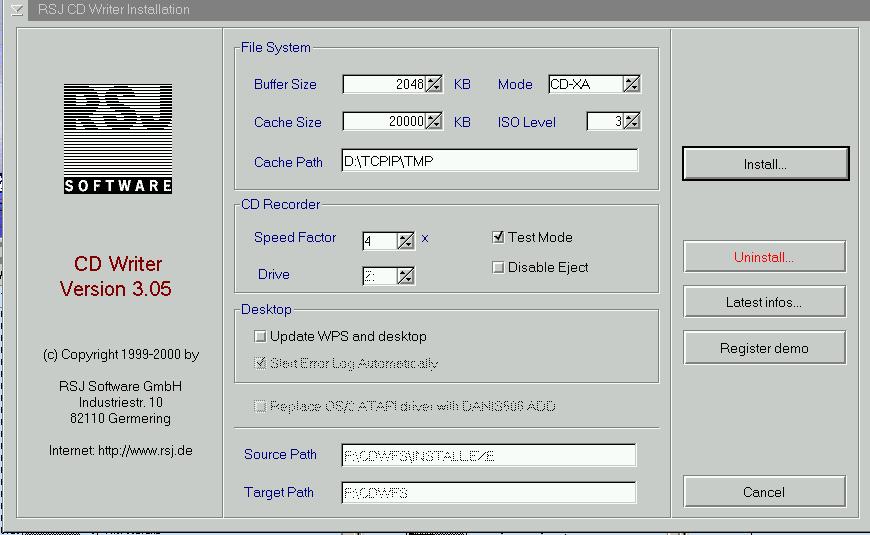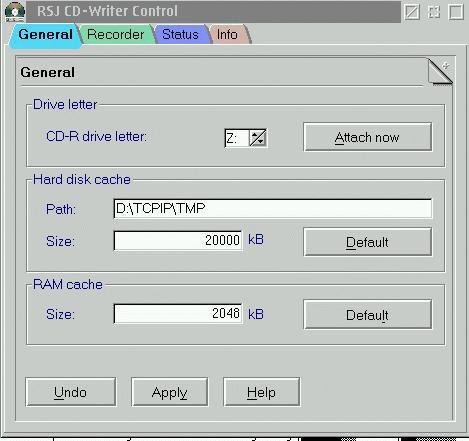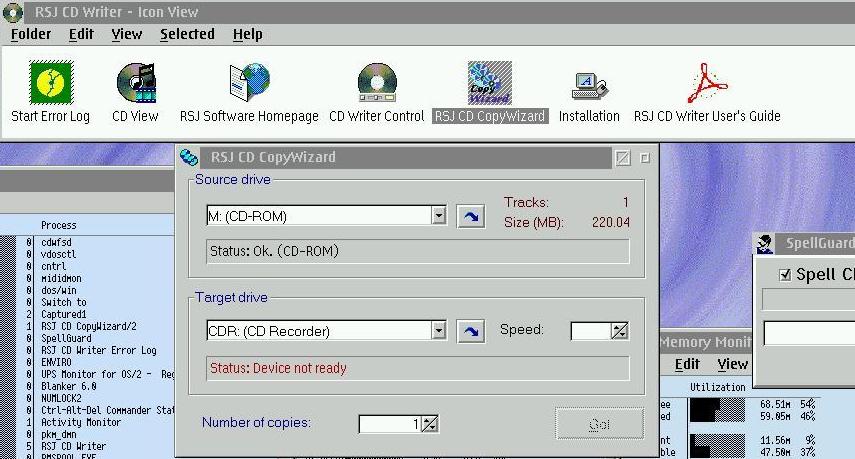 VOICE Home Page: http://www.os2voice.org |
[Previous Page] [Next Page] [Features Index] |
 VOICE Home Page: http://www.os2voice.org |
[Previous Page] [Next Page] [Features Index] |
By Louis
Muollo ©August 2000RSJ:http://www.rsj.de |
Editor note: RSJ Cd Writer for OS/2 2.80 was reviewed previously
in the July 1999 issue of the VOICE Newsletter http://www.os2voice.org/VNL/past_issues/VNL0799H/vnewsf2.htm
Each OS is Drive C, has its own Seagate SCSI disk, and is unhidden by Boot Manager
as needed, on a P120 system, Intel Advanced ML mainboard, Creative Labs AWE64 sound
card. The CD player is a Plextor 20 speed SCSI unit. Recording is done by a Plextor
RW 4/2/20 SCSI unit. The sound card input has access to a turntable, cassette deck,
reel-to-reel Revox, and a Pioneer CD player. SCSI is controlled by an Adaptec 2940UW
card. The unit's main purpose is to record CDs and is used to test new programs
and upgrades in OS/2 before use on one of my critical PCs.
As the first version of RSJ did not have CD to CD copying capability, the PC
was set up with CD Creator. At the time, RSJ stated a later version would have this,
and, in keeping with their word of continued OS/2 support, this version did appear.
At $189.00, RSJ was quite a bit higher than Adaptec. One reason stated by RSJ for
this is that they expected to sell many more Windows copies. Is it worth it over
a Windows program? If you have need for a CD copying program, it would be foolish
not to give RSJ's demo download a try.
 The RSJ CD Writer for OS/2 3.05 Installation Screen.
The RSJ CD Writer for OS/2 3.05 Installation Screen.
The next test was two Karaoke CD's my wife uses. These CD's are worth well over
$100.00 each, and I dreaded the thought of them being broken. The first try was
a CD with 3300 (yes, 3300) songs containing music, pictures, and the words highlighted
at the bottom of the screen as you're supposed to sing them. How they do this I
don't know. Both RSJ and Adaptec made successful copies of this. The second CD was
the older and more used of the two with about 2200 songs on it. Adaptec refused
to record this one. RSJ did record it with a warning of an unsuccessful copy of
the main track. However, it did manage to make a good, usable recording. On the
other hand, only Adaptec could copy a Mac CD byte for byte that neither OS/2 nor
Windows could see. Both programs failed on certain audio CDs, such as Pink Floyds
Dark Side of the Moon CD, leaving dropouts between songs that flow into each
other.
Both programs will quickly copy most music and data CD's, with RSJ having the
greater success rate. Adaptec is more likely to need a disc image to record without
failure. On some program CD's of 32 bit Windows format, RSJ is unable to record
a disk image, but can copy CD to CD without a hitch.
With a small utility to record to disk, records and tapes can be transferred
to CD. In RSJ's case, the music is recorded to disk, transferred to its CDWFS/Tracks
directory, and simply drag-and-dropped in the recording window, all at once or in
any order you choose. The recordings were named in Filestar when completed, so when
transferring for copying to CD it is known which is which. Or, if you have enough
disk space, you can record one large block to fill the CD without breaks, in which
case you can't skip or jump to individual tracks. But at least you don't have the
dropouts on Dark Side of the Moon.
On bootup, RSJ changes the recorder to WORM which leaves it inaccessible
to the operating system. This means that to check your CD, it is best to have a
second player in the system anyway, not just to dupe CD's. With only a CDRW unit,
all material on a CD has to be copied to a hard disk before transfer.
For system data, RSJ has the option to attach an assigned drive letter to the
CDRW. OS/2 then sees it as a drive, and you can use OS/2's copy
command to transfer any files to CD. The procedure is simple. Open RSJ's CD Control
and attach the CDR drive to a driveletter, in my case L, open an OS/2 window
and type format L:. This only takes a second and allows
OS/2 to know what it is writing to. Then type

I have successfully backed up a Nova QIX file to a CD, then used Novadisk to
restore. This gives me a hard copy of my system files that cannot be erased.
CDRW can be used for a changeable CD backup, but with blank CD-Rs selling for about
a dollar, it's worth it to have a few around. Assigning the CDR a drive letter puts
it under OS/2's rules, a plus for file storage and management. There is also a utility
available on Hobbes to make bootable CD's, should you desire this. Any file or files
can be permanently stored on CD, and viewed or copied back to the harddrive using
a file manager such as Filestar, or from a command prompt.
The new version 3.05 of RSJ adds a Copy Wizard, which copies with a mouseclick,
and allows multiple copies without breaking stride. Version 3.05 also increases
the number of CDR units recognized. Most of the recording mentioned here was done
on RSJ Version 2.85.

The power of OS/2 channeled into CD recording makes RSJ well worth the investment
in my opinion. The continued support of RSJ for the OS/2 operating system, and the
excellent tech help available, the on-line forum available on RSJ's website all
combine to make this software worth having. It also offers a good way to not have
to use Windows. I've seen sale prices on RSJ drop to around $120.00, which puts
it in the ballpark with other CDR software by companies that do not support OS/2.
Emails for tech help are answered promptly and efficiently.
Even if I was running Windows, I would purchase RSJ before any other for this
reason. Others may prefer to use Adaptec's CD Creator, but, having access to both,
I always use the OS/2 RSJ setup. I consider it easier to use than CD Creator, because
OS/2 can handle so much, leaving the software with less baggage. This is definitely
an A+ program.